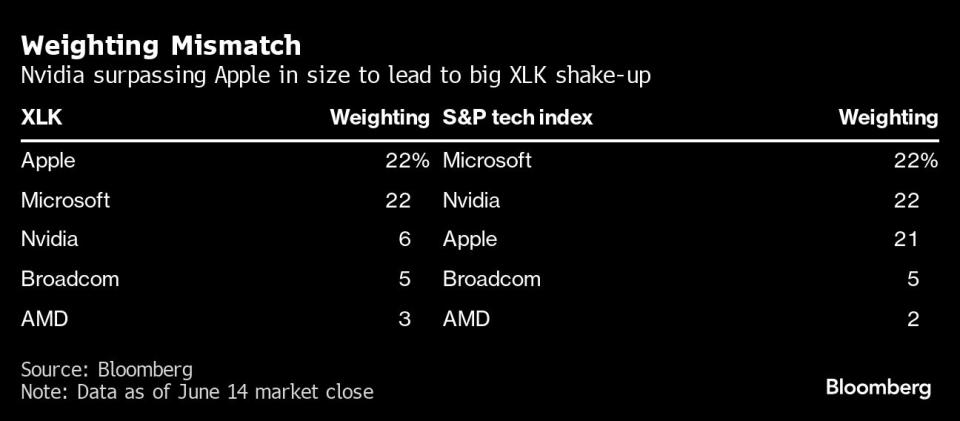Big Reshuffle of $71 Billion ETF Looms as Nvidia Surpasses Apple
(Bloomberg) — One of the world’s most prominent technology ETFs looks poised for a big rebalancing that would ramp up exposure to Nvidia Corp. (NVDA) at the expense of Apple Inc. (AAPL) – spurring billions of dollars in trading volume in one fell swoop.
Most Read from Bloomberg
Flesh-Eating Bacteria That Can Kill in Two Days Spreads in Japan
These Are the World’s Most Expensive Cities for Expats in 2024
How the US Mopped Up a Third of Global Capital Flows Since Covid
S&P 500 Races Toward 30th All-Time High of 2024: Markets Wrap
Barring an 11th-hour deviation from the methodology set out by index provider S&P Dow Jones Indices, State Street Global Advisors is on track to revamp the composition of its $71 billion Technology Select Sector SPDR Fund (XLK) after Nvidia’s market value closed above Apple on Friday.
For months, XLK has held way fewer Nvidia shares even as the AI giant soared 166% year-to-date. When the chipmaker ranked in third place, it made up roughly 6% of the ETF’s assets, compared with 22% in the S&P 500 Information Technology Index. The ownership cap, imposed under diversification rules, has caused XLK to underperform massively this year.
While S&P in theory reserves the right to make an exception, industry participants say the ETF is on track to be re-tooled when it enacts the quarterly rebalance near the end of June.
On that basis, Apple and Nvidia are set to reverse their positions in the ETF with the former’s weight dropping to 4.5% and the latter rising above 20%, according to calculations sent by the index provider to three market participants familiar with the matter.
State Street stands to purchase $11 billion of Nvidia shares and dump $12 billion of Apple, one estimate shows. That’s not insignificant — the forecast sale in Apple shares is equal to the average daily trading value in the past three months.
“By our calculation, the flip-flop between Nvidia and Apple will occur,” said Chris Harvey, head of equity strategy at Wells Fargo Securities. “This aligns the XLK ETF more closely with the momentum trade and semis. At the margin, it’s more dollars chasing a stock that does not need any additional help.”
A spokesperson for S&P declined to comment on potential index changes and referred Bloomberg News to the methodology.

Matt Bartolini, head of SPDR Americas Research at State Street, said XLK will rebalance according to its rules and the methodology. The ETF is obliged to track the S&P benchmark that is designed to stay in compliance with the diversification regulations.
The rules “have served investors well,” he said.
S&P has left the door open to making an exception when it unveils sector weightings at the end of the month, judging by a document sent late last week and seen by Bloomberg News.
The index committee “reserves the right to make exceptions when applying the methodology if the need arises,” S&P wrote in a note regarding the June rebalance. “In any scenario where the treatment differs from the general rules stated in this document or supplemental documents, clients will receive notice, whenever possible.”
S&P said it will send clients so-called proforma documents related to the rebalance for sector indexes each day through Friday.
Any last-minute deviation from the public methodology would not be taken well by traders, who tend to take positions in anticipation of possible revisions in index rebalances like this. While it’s getting crowded, buying stocks that are entering major indexes and selling those that are exiting them has become one of the most reliable strategies for the hedge fund world.

Underpinning the massive adjustments in the duo’s weightings in the ETF are diversification rules dating back more than 80 years that were established to safeguard investors from concentrated bets. Under those rules, the combined representation of the largest companies — those making up roughly 5% or more of a diversified fund — can’t add up to more than 50%.
Similar restrictions last year spurred the overseer of the Nasdaq 100 to conduct a special rebalance to keep index-tracking funds in compliance with the rules. When this rule is breached, indexes such as the Nasdaq 100 tend to trim the top holdings proportionally. XLK’s methodology works differently. When a number of stocks are not in compliance, the smallest of those gets clipped.
This unique rule is why Nvidia has been massively under-owned by XLK, leading the fund to trail the traditional S&P 500 tech sub-index by more than 5 percentage points this quarter — the widest dispersion since 2001.
With the semiconductor pioneer catching up to Apple and Microsoft Corp. in size during recent weeks, XLK’s upcoming rebalances have garnered Wall Street interest given the prospect of volatility-inducing weight additions and reductions to some of the world’s most closely watched tech companies.
“I am interested to see if they keep the rules the same through the next rebalance in September,” said James Seyffart, ETF analyst at Bloomberg Intelligence. “If Apple manages to surpass Nvidia or Microsoft by the next rebalance reference date — which is September 13th — we could have a mirror image massive rebalance where Apple is bought to the tune of billions and Nvidia or Apple are sold to the tune of billions.”
Most Read from Bloomberg Businessweek
Google DeepMind Shifts From Research Lab to AI Product Factory
Trump’s Planned Tariffs Would Tax US Households, Economists Warn
It Will Take More Than US Bargaining Power to Cut Drug Costs
Grieving Families Blame Panera’s Charged Lemonade for Leaving a Deadly Legacy
©2024 Bloomberg L.P.